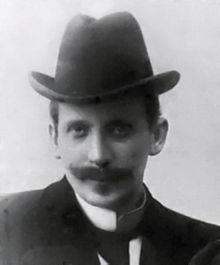Adolph Goldberg
Adolph Goldberg , also Adolf Goldberg , (born February 13, 1860 in Soltau , † November 10, 1938 in Burgdamm ) was a German doctor in Bremen and a Jewish victim of the Nazi regime.
Life
education and profession
Goldberg was the son of a merchant. He grew up in Burgdamm and attended secondary school in Vegesack . He studied science and medicine at the University of Göttingen and received his doctorate Dr. med. In 1888 he settled down as a general physician and obstetrician in a practice at Bahnhofstrasse 144 (today Bremerhaven Heerstrasse 18) in Burgdamm. In 1895 he married Martha Sussmann, the daughter of a wealthy businessman from Schwerin . Since then, Martha Goldberg has worked as an office assistant, secretary and accountant for the practice. They both had three children who were born in the late 1890s. The couple supported people in their area who were in social need. Goldberg became a medical councilor in 1918. He is said to have been a humorous and socially minded doctor who was also known in the population as a “doctor for the poor”.
National Socialism and Reichspogromnacht
During the time of National Socialism in Bremen , the Goldbergs were discriminated against and persecuted as Jews. The wealthy couple, who had a wide range of social contacts until 1933, now lived alone. In 1938, Goldberg lost his medical license according to the “Fourth Ordinance to the Reich Citizenship Law” and had to close his medical practice.
The Goldbergs were murdered in the November pogroms from November 7th to 13th, 1938 . After the Bremen mayor and leader of the Bremen SA group Heinrich Böhmcker had triggered a terrorist action against Jews for Bremen from Munich, the Lesum SA commander Hauptsturmführer and commercial employee Fritz Köster gave the orders to shoot the couple. The murderer was SA-Oberscharführer and engineer August Frühling, who shot the couple on the morning of November 10, 1938 at five o'clock.
Martha and Adolph Goldberg were buried in the Jewish cemetery in Ritterhude .
After the Second World War , Köster was sentenced to life in prison and, in the appeal proceedings in 1948, to 15 years in prison and in spring to ten years in prison. Spring was released in 1951 and Köster in 1953.
Commemoration
- In 1982 the memorial for the victims of the “Reichskristallnacht” was erected in front of the Landherrnamt , which commemorates Martha and Adolph Goldberg and the other three Jewish victims of the Reichspogromnacht in Bremen. Every year on November 10th, the parliamentary groups of Bremen's citizenship and the Jewish community commemorate the event and its victims in a memorial hour at the memorial.
- The Goldberg place at the Bremerhaven highway in Burgdamm was named after the couple.
- A memorial stone was placed on Goldbergplatz in 1985 to commemorate the murder of the couple. Memorial hours are held here every year on November 10th.
- On November 10, 2005, the Cologne artist Gunter Demnig laid two stumbling blocks in the sidewalk in front of the Goldbergs' former house in Burgdamm to commemorate the couple.
literature
- Wilhelm Lührs and others: "Reichskristallnacht" in Bremen - Prehistory, course of events and judicial handling of the pogrom of 9/10. November 1938 . Ed .: Senator for Justice and Constitution of the Free Hanseatic City of Bremen, Steintor Verlagsges., Bremen 1988, ISBN 3-926028-40-8 .
- Rolf Rübsam: They lived among us. In memory of the victims of the "Reichskristallnacht" in 1938 in Bremen and the surrounding area . Hauschild Verlag, Bremen 1988, ISBN 3-926598-09-3 .
- Herbert Black Forest : The Great Bremen Lexicon . Volume: supplementary volume . A – Z. Edition Temmen, Bremen 2008, ISBN 978-3-86108-986-5 .
Web links
- Dr. Adolph Goldberg, * 1860 in the project " Stolpersteine Bremen"
Individual evidence
- ↑ Exhibition collective: The November Pogrom 1938 in Bremen (PDF; 10.9 MB)
- ↑ Press release from the Senate: “Stumbling blocks” project - announcement
| personal data | |
|---|---|
| SURNAME | Goldberg, Adolph |
| ALTERNATIVE NAMES | Goldberg, Adolf |
| BRIEF DESCRIPTION | German doctor in Bremen and a Jewish Nazi victim |
| DATE OF BIRTH | February 13, 1860 |
| PLACE OF BIRTH | Soltau |
| DATE OF DEATH | November 10, 1938 |
| Place of death | Castle dam |


